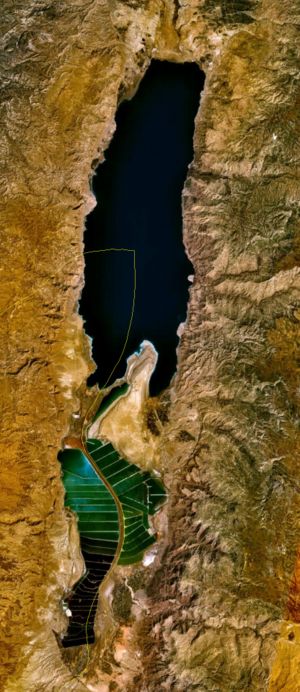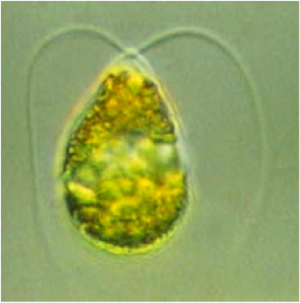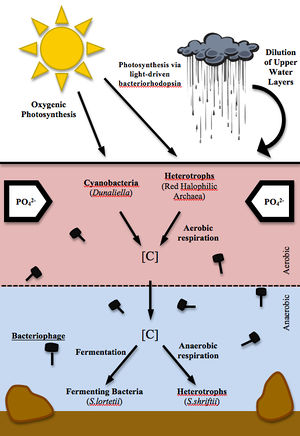Hypersaline Lakes and the Dead Sea
General Introduction
Mineral salts accumulate in lakes when the rate of evaporation or the withdrawal of freshwater exceeds the rate of replacement. When salt concentrations reach levels that exceed that of seawater, the lake is defined as hypersaline and can only be tolerated by organisms with extreme adaptations. One feature of hypersaline lakes, which makes them distinct from other extreme environments, is that they harbor a diverse population of both bacteria and archaea. These microorganisms have evolved a variety of mechanisms to resist the osmotic stress exerted by the high concentrations of mineral salts within the brine, enabling them to thrive in hypersaline lakes around the globe.
The Dead Sea is an example of a hypersaline lake situated between the borders of Jordan and Israel and intakes fresh water from the Jordan River. The Dead Sea is an important source of potash, bromine, and magnesium for Israeli and Jordanian mineral industries and is approximately 630km2 with a maximum depth of 300m [2]. It is also the lowest terrestrial environment, being positioned 423m below sea level. The Dead Sea is, in fact, not dead, but is inhabited by a highly diverse group of microorganisms, derived from various taxa, even though the harsh conditions reduce population sizes. In fact, blooms of microorganisms have been observed only when rainfall has diluted the waters of the Dead Sea.
Physical and Chemical Conditions
Total salt concentration and ionic composition are properties used to classify different high salinity lake systems into two major subgroups: thalassohaline and athalassohaline environments [1].
Thalassohaline environment
This environment commonly exists as inland salt lakes that are derived from seawater and are subject to continuous, extensive evaporation. Consequently, the ionic composition of thalassohaline brines is similar to those found in the sea [1]. High evaporation rates induce the precipitation of gypsum, resulting in the depletion of calcium and sulfate [1,5]. Sodium chloride is found to be the most abundant salt, which explains the slightly alkaline pH of these lakes [1,5]. However, neutral pH values have also been recorded [4]. Common thalassohaline brines include solar salterns, salt mine drainage waters, playas, and brine springs from underground salt deposits.
Athalassohaline environment
The ionic composition of athalassohaline environments is in sharp contrast to that of seawater. There are numerous athalassohaline environments that have their own distinct ionic composition. One unique athalassohaline environment is described below.
Dead Sea
Chemistry
Currently, the concentration of mineral salts within the Dead Sea is almost ten times higher than that of seawater [2,3]. 1977 marked a turn in the chemistry of the lake as sodium chloride reached its maximum concentration after continuous dry seasons with little input of freshwater [2,10]. Ever since, the concentration of sodium chloride in the lake has decreased by 11% due to the precipitation of salts, in the form of halite, along the bottom of the lake [2,10]. Today, divalent cations such as magnesium and calcium are more abundant than monovalent cations such as sodium and potassium [1,2,4]. Furthermore, 99% of all anions are chlorine ions while the remainder are mostly bromine ions [2,10]. Unlike other brines, the Dead Sea has an acidic pH within a range of 5.8-6.0 [1,2,10].
Temperature
The Dead Sea is situated in a very dry climate that is predicted to become drier as greenhouse gases continue to accumulate in the eastern Mediterranean [9]. Recent measurements indicate that surface water temperature has increased by 1.5oC, while evaporation rates have decreased by 300mm annually [9]. Yet, evaporation and withdrawal of fresh water from the Dead Sea have caused a significant decrease in the water level, exposing numerous sinkholes around the vicinity of the lake [9].
Human implications on salt concentration
The major source of freshwater for the Dead Sea is the Jordan River. Unfortunately, water input into the Dead Sea has decreased from 1500 m3 year-1 to less than 100 m3 year-1 since 1950 [8]. A majority of this freshwater is being collected to supply water poor nations near the Dead Sea with drinking water. The loss of 625 million m3 of freshwater annually is elevating the mineral salt concentration, and consequently, the extreme environmental conditions of the Dead Sea [2].
Israeli and Jordanian mineral industries situated near the southern end of the Dead Sea consume 400-450 million m3 of Dead Sea water annually to isolate and collect various salts [4]. Almost 50% of the concentrated salt products, consisting of magnesium, calcium, and chloride, are transferred back into the Dead Sea, further increasing salt concentrations [4].
Key Microorganisms
Microorganisms that inhabit hypersaline lakes may be halotolerant or halophilic. The ability to tolerate high salt concentrations without compromising growth is characteristic of halotolerant microorganisms. Microorganisms that have adaptations which require salt as a growth factor are referred to as halophilic. Both halophilic and halotolerant microorganisms perform one of two different mechanisms to ensure that they can persist in the high salt concentrations of hypersaline environments. One strategy involves the accumulation of inorganic salts in the cytoplasm of the cell with the purpose of making the cytoplasm isotonic to the environment. Other microorganisms prevent salts from accumulating in the cytoplasm of the cell by actively pumping out ions and storing organic solutes to counter the osmotic stress due to high salt concentrations. These organisms are much more flexible, as they can adapt to rapid changes in salt concentrations.
A majority of prokaryotes in the Dead Sea are halophiles. The first microorganisms in the Dead Sea were identified in the 1930’s and included algae, protozoa, and ciliates as well as microbes belonging to the domains Bacteria and Archaea [11]. Today, protozoans have been eradicated from the microbiota of the Dead Sea, possibly due to the extreme conditions imposed by the 20% increase in sea surface salinity since the 1930’s [2]. The microbial community of the Dead Sea is unique to the lake and is well adapted to its hostile conditions. Microorganisms have evolved mechanisms to resist the harmful effects of magnesium at high concentrations. Filamentous fungi have also been isolated from the Dead Sea [2]. The different microorganisms identified in the Dead Sea are listed below.
Red Halophilic Archaea
Halorubrum sodomense
Halobaculum gomorrense
Haloplanus natans
Aerobic Bacteria
Halomonas halmophila
Chromohalobacter marismorui
Chromohalobacter israelensis
Salibacillus marismortui
Anaerobic Bacteria
Halobacteroides halobius
Sporohlalobacter lortetii
Orenia marismortui
Selenhihalanaerobacter shriftii
Microbial Processes
The hostile conditions of hypersaline lakes do not limit the metabolic diversity of halophiles, even under saturating halite concentrations. In fact, a majority of the dissimilatory metabolisms documented in the literature can function in extreme hypersaline environments [1]. However, each hypersaline environment harbors distinct chemistries that determine what types of metabolisms prevail. The following are microbial processes that are common in all hypersaline lakes.
Oxygenic photosynthesis
This form of metabolism can occur at the highest of halite concentrations and is commonly performed by eukaryotic algae of the genus Dunaliella and cyanobacteria such as Aphanothece halophytica [1]. However, in some environments, such as the Dead Sea, algae belonging to the genus Dunaliella are the only oxygenic photosynthesizers.
Anoxygenic photosynthesis
This form of metabolism can be performed at halite saturation by microorganisms belonging to the Purple bacteria and Green Non-Sulfur bacteria phylogenies [1]. The Dead Sea is an example of an environment that lacks such organisms.
Aerobic respiration
Substrates that are very difficult to degrade in other environments can be degraded aerobically in hypersaline lakes. The degradation of aromatic compounds such as genzoate, cinnamate, and phenylpropionate and long-chain fatty acids, such as palmitic acid have been identified in brines [1].
Anaerobic respiration
Since the solubility of oxygen decreases at high salinity, it is a major limiting factor in hypersaline environments [1]. Consequently, anaerobic halophilic heterotrophs are the most abundant microorganisms in brines [1]. The electron acceptors that they utilize include nitrate, dimethylsulfoxide, trimethylamine N-oxide, and fumarate [1].
Dissimilatory sulfate reduction
This form of metabolism can be performed at the highest of salt concentrations and is found in all hypersaline lakes, except the Dead Sea [1]. The concentration of sulfate in the Dead Sea is a mere 0.004M, which isn’t enough to sustain the growth of sulfate reducing bacteria [2].
Ecology
Oxygenic and anoxygenic photosynthesis is the only means of primary production in hypersaline lakes. Microbes with the capacity to carry out photosynthesis reside in the upper column of the waterbed, where they produce organic biomass that is degraded by anaerobic and aerobic hetereotrophs. Heterotrophy in salt concentrations higher that 250 g L-1 is most efficiently performed by members of the domain Archaea, with bacteria being less capable to execute the same function [4]. In the presence of high nutrient concentrations, microbial populations can reach 107-108 cells mL-1 [4].
The sole primary producer of the Dead Sea is the green eukaryotic algae, Dunaliella [2]. The growth of Dunaliella is limited by the high salinity and the low phosphate concentrations of the Dead Sea [2]. Consequently, algal blooms are only witnessed when rain floods dilute the upper layers of the waterbed by at least 10% and transfer large quantities of phosphate to the lake [2]. In the absence of these conditions, Dunaliella remains inactive as thick walled cysts buried in the sediments near shallow areas of the lake [2].
Vast algal blooms in the Dead Sea were observed only during the rainy winters of 1980 and 1992 [10]. During this time, the Dead Sea was colored red, indicating the growth of Red Halophilic Archaea [2]. These heterotrophs possess an archaeal carotenoid pigment that gives off a distinct red color at high densities [1,2,4]. During these events, total cell concentrations reached 20-35.6 x 106 cells mL-1 [11]. However, between the two algal blooms and after 1996, Dunaliella could not be detected in the upper water layers of the Dead Sea. Consequently, prokaryote population decreased almost a hundred fold after the bloom [11]. Small populations of Archaea were able to survive in the absence of the Dunaliella, since they were adapted to use light as an energy source to fix carbon dioxide using the retinal pigment, baceriorhodopsin [4]. The decline of prokaryotes after the algal bloom is also attributed to the presence of phages with spindle-shape morphology that specifically infect species of Archaea [2]. It is evident that phages are an important component of the community ecology of the Dead Sea, as they play a critical role in regulating the populations of halophilic Archaea.
An in-depth analysis of the community ecology of the Dead Sea was performed on water samples from 1992 and 2007 using numerous sequencing methods, including 16S rRNA gene analysis [2]. Results identified that the 1992 water sample was uniform, consisting of a single type of Archeaon that was closely related, but not identical, to Halobacterium salinarum [2]. On the contrary, the 2007 sample was comprised of a much more diverse population of microbes, in which most species belonged to the genera Halorhabdus, Haloplanus, and Natronomonas [2]. It is evident from these findings that the microbial communities in the Dead Sea are dynamic.
Current Research
Microbial Life on Mars?
Water was once an abundant source on the surface of Mars, as suggested by the discovery of water in Martian soil [12]. Upon the depletion of the atmosphere, conditions got colder and drier, resulting in the eventual depletion of water from the surface [7,13,15]. As these water basins evaporated, they entered a phase of high salinity that is characteristic of hypersaline lakes [12,14,15]. Halophilic and halotolerant microorganisms, if present, would flourish in these hypersaline lakes. Their remains would eventually be trapped in halite crystals formed upon the complete evaporation of the brine [12]. Future research is focused on identifying halophilic and halotolerant microorganisms on the surface of Mars by finding and analyzing halite crystals from dried basins. Resonance Raman spectroscopy can be used to identify carotenoid pigments, which are abundant along the surface of most halophilic Archaea [12]. This is being considered as a potential tool for identifying Martian halophilic Archaea in the near future [12].
The Dead Sea-Red Sea Canal
The Dead Sea has been shrinking at a rate of 1m year-1 due to the collective impact of extensive evaporation, decrease in freshwater input from the Jordan River, as well as the removal of freshwater from the Dead Sea for salt extraction purposes [2,8,9]. Therefore, Israel, Palestine, and Jordan are facing a freshwater crisis and have collectively proposed the idea of restoring the water level of the Dead Sea by connecting it to the Gulf of Aqaba [3,9]. Models that correctly evaluate evaporation rates of the Dead Sea are being developed to determine the exact volume of water required to maintain the water level at a desired amount [9]. The exact measurement is difficult to achieve as many factors affect the evaporation rates of the Dead Sea [9]. Furthermore, future research is focused on the environmental impact that the project will have on the both the Dead Sea as well as the Gulf of Aqaba. Even though the impact that the project will have on the microbiota of the Dead Sea has not been deduced, the decrease in salt concentrations upon the addition of fresh water to the hypersaline lake is likely to alter the spectrum of microorganisms in the Dead Sea.
References
[1] Oren A. “Life at High Salt Concentrations.” Prokaryotes, 2006, DOI: 10.1007/0-387-30742-7_9
[2] Oren A. “The dying Dead Sea: The microbiology of an increasingly extreme environment.” Lakes & Reservoirs: Research and Management, 2010, DOI: 10.1111/j.1440-1770.2010.00435.x
[3] Qdais HA. “Environmental impacts of the mega desalination project: the Red-Dead Sea conveyor.” Desalination, 2008, DOI: 10.1016/j.desal.2007.01.019
[4] Oren A. “Molecular ecology of extremely halophilic Archaea and Bacteria.” FEMS Microbiology Ecology, 2002, PII: S0168-6496(01)00200-8
[5] Litchfield CD. and Gillevet PM. “Microbial diversity and complexity in hypersaline environments: A preliminary assessment.” Journal of Industrial Microbiology & Biotechnology, 2002, DOI:10.1038/sj/jim/7000175
[6] Ma Y., Galinski EA., Grant WD., Oren A. “Halophiles 2010: Life in Saline Enviornments.” Applied and Enviornmental Microbiology, 2010, DOI: 10.1128/AEM.01868-10
[7] Leuko S., Rothschild LJ., Burns BP. “Halophilic Archaea and the Search for Extinct and Extant Life on Mars.” Journal of Cosmology. 15 Jan. 2010. <http://journalofcosmology.com/SearchForLife113.html>
[8] Oren A., Plotnikov IS., Sokolov S., and Aladin NV. “The Aral Sea and the Dead Sea: Disparate lakes with similar histories.” Lakes & Reservoirs: Reasearch and Management, 2010, DOI:10.1111/j.1440-1770.2010.00436.x
[9] Oroud IM. “Evaporation estimates from the Dead Sea and their implication on its water balance.” Theor Appl Climatol, 2011, DOI: 10.1007/s00704-011-0452-6
[10] Bodaker I., Sharon I., Suzuki MT., Feingersch R., Shmoish M., et al. “Comparative community genomics in the Dead Sea: an increasingly extreme environment.” The ISME Journal, 2010, DOI: 10.1038/ismei.2009.141
[11] Ionescu D., Siebert C., Polerecky L., Munwes YY., Lott C., et al. “Microbial and Chemical Characterization of Underwater Fresh Water Springs in the Dead Sea.” PLoS ONE, 2012, DOI:10.1371/journal.pone.0038319
[12] Leeeowe, B. “Searching For Early Life On Mars.” Weird Sciences. 12 Jun. 2010. <http://bruceleeeowe.wordpress.com/2010/06/12/searching-for-early-life-on-mars/>
[13] Mancinelli, R. “Evolution of halophiles: A terrestrial analog for life in Brines on Mars.” The Smithsonian/NASA Astrophysics Data System. 6-11 Apr. 2003. <http://adsabs.harvard.edu/abs/2003EAEJA.....4360M>
[14] “Salt Lake.” Microbe Wiki. 6-11 Apr. 2003. <http://microbewiki.kenyon.edu/index.php/Salt_Lake>
[15] Mullen L. “Salt of the Early Earth.” Astrobiology Magazine. 11 Jun. 2002. <http://www.astrobio.net/exclusive/223/salt-of-the-early-earth>



